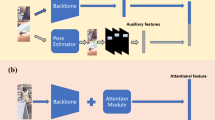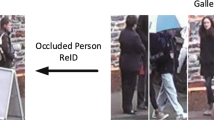Abstract
Occluded person re-identification (Re-ID) is a challenging task in real-world scenarios due to the extensive conditions that persons are occluded by various obstacles. Although state-of-the-art methods with additional cues such as pose estimation and segmentation have achieved great success, they did not overcome data bias and the dependency on the accuracy of other detectors. In this paper, we propose a novel similar feature extraction network (SFE-Net) for occluded person Re-ID to address these issues. Firstly, we introduce the adaptive convolution method to separate the features of occluded and non-occluded regions, where local and global features are sufficiently used. We then apply adaptive aggregating parameters to find a better weighting strategy automatically. Finally, the transformer encoder architecture is utilized for generating discriminative features. Extensive experiments show SFE-Net outperforms state-of-the-art methods on both occluded and holistic datasets.
Access this chapter
Tax calculation will be finalised at checkout
Purchases are for personal use only
Similar content being viewed by others
References
Chen, B., Deng, W., Hu, J.: Mixed high-order attention network for person re-identification. In: 2019 IEEE/CVF International Conference on Computer Vision (ICCV), pp. 371–381 (2019). https://doi.org/10.1109/ICCV.2019.00046
He, K., Zhang, X., Ren, S., Sun, J.: Deep residual learning for image recognition. In: 2016 IEEE Conference on Computer Vision and Pattern Recognition (CVPR), pp. 770–778 (2016). https://doi.org/10.1109/CVPR.2016.90
Hermans, A., Beyer, L., Leibe, B.: In defense of the triplet loss for person re-identification. CoRR abs/1703.07737 (2017). http://arxiv.org/abs/1703.07737
Hou, R., Ma, B., Chang, H., Gu, X., Shan, S., Chen, X.: Interaction-and-aggregation network for person re-identification. In: 2019 IEEE/CVF Conference on Computer Vision and Pattern Recognition (CVPR), pp. 9309–9318 (2019). https://doi.org/10.1109/CVPR.2019.00954
Huang, H., Li, D., Zhang, Z., Chen, X., Huang, K.: Adversarially occluded samples for person re-identification. In: 2018 IEEE/CVF Conference on Computer Vision and Pattern Recognition, pp. 5098–5107 (2018). https://doi.org/10.1109/CVPR.2018.00535
Li, W., Zhu, X., Gong, S.: Harmonious attention network for person re-identification. In: 2018 IEEE/CVF Conference on Computer Vision and Pattern Recognition, pp. 2285–2294 (2018). https://doi.org/10.1109/CVPR.2018.00243
Li, Y., He, J., Zhang, T., Liu, X., Zhang, Y., Wu, F.: Diverse part discovery: occluded person re-identification with part-aware transformer. In: 2021 IEEE/CVF Conference on Computer Vision and Pattern Recognition (CVPR), pp. 2897–2906 (2021). https://doi.org/10.1109/CVPR46437.2021.00292
Liao, S., Shao, L.: Interpretable and generalizable person re-identification with query-adaptive convolution and temporal lifting. In: Vedaldi, A., Bischof, H., Brox, T., Frahm, J.-M. (eds.) ECCV 2020. LNCS, vol. 12356, pp. 456–474. Springer, Cham (2020). https://doi.org/10.1007/978-3-030-58621-8_27
Miao, J., Wu, Y., Liu, P., Ding, Y., Yang, Y.: Pose-guided feature alignment for occluded person re-identification. In: 2019 IEEE/CVF International Conference on Computer Vision (ICCV), pp. 542–551 (2019). https://doi.org/10.1109/ICCV.2019.00063
Park, H., Ham, B.: Relation network for person re-identification. In: Proceedings of the AAAI Conference on Artificial Intelligence, vol. 34, pp. 11839–11847 (2020)
Sun, Y., et al.: Perceive where to focus: learning visibility-aware part-level features for partial person re-identification. In: 2019 IEEE/CVF Conference on Computer Vision and Pattern Recognition (CVPR), pp. 393–402 (2019). https://doi.org/10.1109/CVPR.2019.00048
Sun, Y., Zheng, L., Yang, Y., Tian, Q., Wang, S.: Beyond part models: person retrieval with refined part pooling (and a strong convolutional baseline). In: Ferrari, V., Hebert, M., Sminchisescu, C., Weiss, Y. (eds.) ECCV 2018. LNCS, vol. 11208, pp. 501–518. Springer, Cham (2018). https://doi.org/10.1007/978-3-030-01225-0_30
Szegedy, C., Vanhoucke, V., Ioffe, S., Shlens, J., Wojna, Z.: Rethinking the inception architecture for computer vision. In: 2016 IEEE Conference on Computer Vision and Pattern Recognition (CVPR), pp. 2818–2826 (2016). https://doi.org/10.1109/CVPR.2016.308
Tay, C.P., Roy, S., Yap, K.H.: AANet: attribute attention network for person re-identifications. In: 2019 IEEE/CVF Conference on Computer Vision and Pattern Recognition (CVPR), pp. 7127–7136 (2019). https://doi.org/10.1109/CVPR.2019.00730
Vaswani, A., et al.: Attention is all you need. In: Advances in Neural Information Processing Systems, vol. 30 (2017)
Wang, G., et al.: High-order information matters: learning relation and topology for occluded person re-identification. In: 2020 IEEE/CVF Conference on Computer Vision and Pattern Recognition (CVPR), pp. 6448–6457 (2020). https://doi.org/10.1109/CVPR42600.2020.00648
Woo, S., Park, J., Lee, J.-Y., Kweon, I.S.: CBAM: convolutional block attention module. In: Ferrari, V., Hebert, M., Sminchisescu, C., Weiss, Y. (eds.) ECCV 2018. LNCS, vol. 11211, pp. 3–19. Springer, Cham (2018). https://doi.org/10.1007/978-3-030-01234-2_1
Zhao, L., Li, X., Zhuang, Y., Wang, J.: Deeply-learned part-aligned representations for person re-identification. In: 2017 IEEE International Conference on Computer Vision (ICCV), pp. 3239–3248 (2017). https://doi.org/10.1109/ICCV.2017.349
Zheng, L., Shen, L., Tian, L., Wang, S., Wang, J., Tian, Q.: Scalable person re-identification: a benchmark. In: 2015 IEEE International Conference on Computer Vision (ICCV), pp. 1116–1124 (2015). https://doi.org/10.1109/ICCV.2015.133
Zheng, Z., Zheng, L., Yang, Y.: Unlabeled samples generated by GAN improve the person re-identification baseline in vitro. In: 2017 IEEE International Conference on Computer Vision (ICCV), pp. 3774–3782 (2017). https://doi.org/10.1109/ICCV.2017.405
Zhong, Z., Zheng, L., Kang, G., Li, S., Yang, Y.: Random erasing data augmentation. In: Proceedings of the AAAI Conference on Artificial Intelligence, vol. 34, August 2017. https://doi.org/10.1609/aaai.v34i07.7000
Acknowledgements
This paper is supported by Shandong Province Key Innovation Project (Grant No. 2020CXGC010903 and Grant No. 2021SFGC0701).
Author information
Authors and Affiliations
Corresponding author
Editor information
Editors and Affiliations
Rights and permissions
Copyright information
© 2022 Springer Nature Switzerland AG
About this paper
Cite this paper
Jiang, X., Liu, J., Han, Y., Gu, L., Liu, X. (2022). Similar Feature Extraction Network for Occluded Person Re-identification. In: Tan, Y., Shi, Y., Niu, B. (eds) Advances in Swarm Intelligence. ICSI 2022. Lecture Notes in Computer Science, vol 13345. Springer, Cham. https://doi.org/10.1007/978-3-031-09726-3_29
Download citation
DOI: https://doi.org/10.1007/978-3-031-09726-3_29
Published:
Publisher Name: Springer, Cham
Print ISBN: 978-3-031-09725-6
Online ISBN: 978-3-031-09726-3
eBook Packages: Computer ScienceComputer Science (R0)




